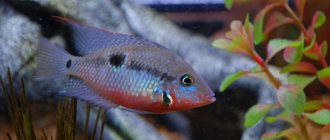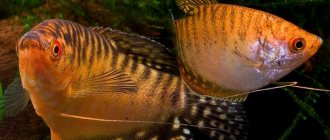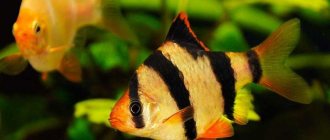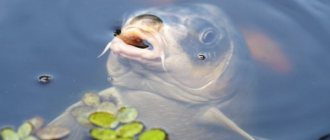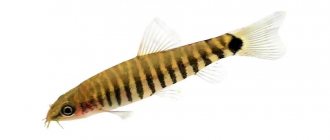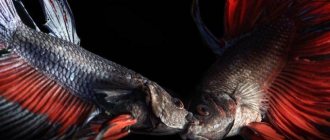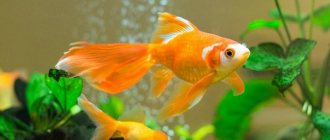Botsia the clown: grace and beauty!
If you have ever admired nimble fish with bright orange and black stripes, you couldn’t help but fall in love with them! They are so unique that, compared to other inhabitants of aquariums, they seem to be aliens from another world. These unusual creatures are the clown botia. Another common name is Botia macracantha.
The name Macracanthus comes from two words: “macro”, which means large, long, and “acanthus” - thorny, thorny. This is due to the physiological characteristics of the species. If you frighten a loach, it will release spines from its suborbital sinuses (like many loaches).
This unusually beautiful fish was first described by the Dutch scientist Pieter Blecker in the mid-19th century. Macracanta lives in the fresh waters of Indonesia, Sumatra, Borneo, where, by the way, it is eaten like hake by local aborigines.
During spawning and the monsoon season, the loachfish, which usually lives in large schools, migrates.
In the biotope, the size of the fish reaches 30-40 cm. In terms of life expectancy, the botia is a real long-liver. It can easily last 20 years.
Botia clown photo
Botia belongs to the loach family of fish. It got the name “clown” for its bright striped coloring, similar to a jester’s clothes. Note that over the years the colors gradually fade. There are three black stripes on the elongated body: the first crosses the eyes, the central one is located directly in front of the fin on the back, the next stripe partially covers the dorsal fin and continues to the tail. The fins are usually black, but the lower ones are sometimes red.
The eyes are large and not protected by a skin film. Mouth with several pairs of whiskers pointing downwards. The maximum size in an aquarium is 20-25 cm.
Bots interesting video review
Botia clown ibn makrakantha is an unpretentious fish to keep. But there are also subtleties that should definitely be taken into account.
These fish need space. Botsia are schooling fish. It is better to purchase at least 3–5, and if the size of the aquarium allows, then more clowns.
The optimal volume of water is calculated based on the fact that there should be ~ 50+ liters for each macrocanthus. For five fish, an aquarium with good water filtration is suitable for 400–500 liters. Of course, you can use a small aquarium for young animals, but keep in mind that fish grow quite quickly.
The quality of the habitat in an artificially created reservoir is very important for them; ammonium/ammonia can lead to illness and even death of the inhabitants. Optimal values for clowns: from 5 to 12 dH, at PH 6–6.5 and at a temperature of 24–28C. Every week it is necessary to update the water by 25–30%. Aeration and filtration are mandatory conditions.
The most important thing in keeping bots is that there are no excessive concentrations of nitrogen compounds and phosphates . Every conscientious aquarist should always have a set of drop tests on hand, at least for nitrate and phosphate. Fortunately, they have now become inexpensive, there are no problems with their assortment and acquisition. For example, we can with a clear conscience recommend you the cool UHE drop tests, , but they are sold only online. In stores in your city - offline, you can find inexpensive Vladox tests .
Since loaches are scaleless and quite delicate fish, when changing water with clean tap water, it is advisable to use drugs that block harmful substances. For example, Tetra AquaSafe - it blocks chlorine compounds, heavy metals + contains B vitamins, iodine and other aquarium goodies. Bots will appreciate this!
The favorite game of all fighters is hide and seek. Grottoes, crevices, caves and snags are great fun for them. They prefer diffused, dim lighting - these are crepuscular fish, although in captivity you can admire their frisky games during the day. It is preferable to use hard-leaved plants in the aquarium so that the bots do not have the desire to feast on them. Ferns, Cryptocoryne, Echinodorus or Anubias are suitable.
Don't forget to cover the aquarium with a lid. Otherwise, the nimble fighters may jump out of their water world. And the roach turned around to meet Neptune.
Description
A fish with bright colors and lively character. The age of the botia in rare cases exceeds 20 years. Leads a diurnal lifestyle, which is uncharacteristic for representatives of the genus Botia.
Appearance
The body is elongated, compressed in cross section. The back is rounded, the abdomen is straight. The scales are small and vulnerable. In nature they grow up to 35–45 cm, aquarium fish Clown botia – 18–25 cm.
It got its name for its body color: golden with a red tint with three black or dark gray transverse stripes. The head dark line covers the eyes, the back part of the dorsal and anal fins. In Western countries it is called “Tiger Loach”.
The dorsal and anal fins are triangular. The caudal fin is forked. The fins of the clown loach continue the color of the body, but with a red tint. In adult individuals, the colors of the body and fins become less saturated.
The mouth is small, with four pairs of antennae for searching for prey and navigating in muddy water. Protruding spikes are hidden under the eyes.
Behavior
The clown botsia fish is active during the day and is curious. Loves shelters in plants, hiding places in rock grottoes. Its lifestyle is bottom-dwelling, but it jumps out of the aquarium. Undermines aquarium equipment. Resting on the side, back, in an upright position.
View this post on Instagram
Prachtschmerle #tiere #animals #fische #fish #zierfische #prachtschmerle #schmerlen #chromobotia #chromobotiamacracanthus #sumatra #bodenfische
A post shared by Dieter Götz (@dietergoetz38) on Nov 24, 2021 at 8:48am PST
Eats aquarium shellfish. When there is a lack of plant food, it eats plants. When frightened and while eating, the spines are exposed with a characteristic click. In a stressful situation, the color fades and the fish pretends to be dead.
Lifespan
Long-lived, live 15–20 years.
Spreading
You can meet the clown loach in its natural habitat on the islands of Southeast Asia. Fish do especially well in Borneo and Sumatra. They thrive in the warm waters of local rivers and streams. Moreover, the purity of the water is not important to them: muddy springs are inhabited by clowns no worse than crystal clear ones.
Local residents are interested in brightly colored loaches mainly from a gastronomic point of view. They make delicious dishes with a subtle aroma.
Kinds
The clownfish does not belong to the genus Botia and is distinguished by its bottom-dwelling lifestyle. The structure of the body and fins, the presence of four pairs of whiskers, spines for defense against large fish. Botia are nocturnal and collect food at the bottom. They are gregarious, but love shelter. Not aggressive. With small scales and easily injured skin.
They eat shellfish and plants. Omnivores, require plant foods. Below we briefly describe the types of bots common in aquariums.
Morleti (Botia morleti)
English names: Mouse Loach, Cream Loach. In an aquarium, the length is 8–10 cm. The color is light brown with dark streaks. Characteristic is a black or dark gray line on the back from the upper lip to the tail. In front of the caudal fin, the mark turns into a circular vertical line. The fins are transparent, sometimes with a yellow or orange tint. The tail has dark spots. The color does not change with age.
Lives in an aquarium for 6–8 years.
Royal (Botia berdmorei)
She is Beardmore's loach, Burmese, tiger. In an aquarium it grows up to 18–20 cm. The body color is yellowish, with black or dark gray vertical stripes and spots. The fins are reddish, with dark spots.
They live 8–10 years.
Dario (Botia dario)
In other words, Bengal botsia, Geto. Size - 12–14 cm. The body is gray-black, with golden vertical stripes. The fins are transparent, the tail has black spots.
Life expectancy is 8–12 years.
Leconte (Botia lecontei)
Otherwise, silver loach. Grows up to 15 cm in length. Color depends on habitat. Changes from silver to blue-gray. There is a dark ring in front of the caudal fin. The fins are transparent or have a yellow or orange tint.
Lives in an aquarium for 8–9 years.
Zebra (Botia striata)
Botia striata, striped. In an aquarium it grows up to 8–9 cm. The color consists of alternating golden and dark gray or pale brown transverse stripes. Feature: reddish lips. The color of the fins matches the background of the body.
Life expectancy is 10–12 years.
Dwarf (Botia sidthimunki)
Reticulated botia, hummingbird. Up to 4–5 cm long. The body is dark gray, black with ordered silvery spots. The abdomen is light. The fins are transparent.
They live 5–8 years.
Blue (Botia modesta)
Or botia modesta. The length in the aquarium is 14–15 cm. The body color is gray with a blue or green tint. The fins are yellow or orange.
Life expectancy is 10–12 years.
Macracanta
Same as clown botia.
Kubotai (Botia kubotai)
She's a chess fighter. Length - 10–12 cm. Main color - dark gray with a purple tint with light spots. The color of the fins duplicates the color of the body.
They live 8–10 years.
Rostrata (Botia rostrata)
Long-snouted, two-ribbon botia. They grow up to 8–10 cm. The color is light gray with dark patterns. The fins are transparent, the dorsal and caudal fins have dark spots.
Life expectancy is 7–9 years.
Histrionica (Botia histrionica)
Or Assamese botia. They grow up to 10–12 cm. The main color background is silver. With black and brown curly stripes in the form of Y or 8ki. The fins are colorless, with dark spots.
They live 5–8 years.
Almora (Botia almorhae, Botia lohachata)
She is also a marbled botsia, lohakata, in English Pakistani loach (Pakistan loach), YoYo loach. Adults are 10–15 cm long. The body is colored light silver with dark patterns. Fins are the same color as the body.
Lives in an aquarium for 6–8 years.
Emperor (Botia emperor)
Imperial battle. Up to 12–14 cm in length. Color: gray, black patterns on a yellow background. Fins in body color.
Lives 7–9 years.
Best neighbors
The character of clowns largely depends on how large the flock in which they live is. Keeping bots of this variety alone or in pairs is a big mistake.
Quite quickly they get bored, and for the sake of entertainment they begin to attack everyone who comes under the fin. Injuries inflicted on opponents can be quite serious.
The level of aggression decreases as the number of clowns in the aquarium increases. In a large team, they are so carried away by building a hierarchy and relationships “between their own” that there is no time to pay attention to their neighbors.
However, some fish should not be added to them. First of all, you should focus on size. If the neighbor turns out to be too small, there is a high chance that the bot will not resist the temptation to feast on him.
Clowns also pose a certain danger to fish with long tails and fins. Such beauty will undoubtedly arouse their interest. They will quench it immediately and in the only accessible way, that is, by tasting it.
A clown can build good neighborly relations with:
apistograms
angelfish
barbs
irises
other fish from the loach family
Maintenance and care
It is customary to keep the clown loach in a school of 3–5 or more fish. Objects in the aquarium and the soil should not have sharp fragments: the delicate skin of fish is easily scratched. Good filtration and aeration and weekly water changes are necessary.
Aquarium
- The volume of the aquarium for one clown is from 150 liters.
- For a flock of three individuals - from 250 liters.
- Five fish or more - from 400 liters.
Water parameters
- Water temperature: 24–29 °C.
- Hardness: 1–5°F.
- Acidity: pH 6–7.
To maintain water quality, replace a quarter to a third of the volume with settled water weekly. Siphon, do not allow contaminants to accumulate at the bottom.
Plants
Clowns eat plants when there is a lack of plant food. But plants maintain biological balance in the aquarium and absorb nitrates that are dangerous to fish. Choose hard-leaved Anubias and Cryptocorynes ferns. Protect the roots with pots and large stones.
Hardleaf plants grow slowly, and the leaves become overgrown with algae. But clowns eat algae with pleasure.
From excessive light, clowns hide in shelters. Plants floating on the surface will help regulate the light: riccia, salvinia, duckweed.
Priming
The most vulnerable place for injury on a clown is its antennae. Choose rounded small pebbles and sandy substrate.
Decorative elements
Place artificial shelters in the aquarium:
- driftwood;
- grottoes;
- ceramic and plastic rings;
- massive stones;
- houses.
Design items should not have sharp elements. Clowns' skin is not resistant to injury.
Equipment
- For aquariums with a capacity of 150 liters or more, choose an external filter. Taking into account the tendency of clowns to nitrate poisoning - with a biocomponent. Productivity is calculated based on pumping 5–6 aquarium volumes per hour.
- The compressor and sprayer are designed to create currents familiar to clowns and saturate the water with oxygen. Select productivity at the rate of 1 liter of air per hour per 1 liter of water.
- Siphon for removing food debris and excrement of inhabitants from the bottom.
- Heater with thermostat. Convenient submersible with a horizontal arrangement at the bottom. No need to turn off when changing water. Power: 1 W per 1 liter of water.
- Scraper for removing algae from the walls of the aquarium.
- A lid is required. Clowns are prone to jumping out of the container.
Lighting
Diffused, luminous flux 30–40 lumens per 1 liter of water. Focus on energy-saving and cool lamps: LED, fluorescent.
Character of the battle
Botsia are schooling fish that feel comfortable only in a school. Therefore, you need to keep at least 3-6 pieces in the aquarium. This makes the fish feel more protected and brave. When alone, the fish becomes shy and sometimes dies. Solitary fish show aggressiveness towards other inhabitants of the aquarium, which is unusual for schooling fish.
Aquarists note the accommodating, cheerful nature of the bots in a flock. In the aquarium, these playful, cheerful clowns amuse the rest of the fish, make them move, and involve them in their games. Therefore, slow, passive fish species are not suitable for them as “neighbors”. Owners of Macracantha bots note their bright personality, quick wit, penchant for theatrical performances and a constant desire to misbehave.
Despite the fact that the bots gravitate towards a bottom existence, in the aquarium they willingly “prowse the open spaces” in any direction. The fish quickly maneuver among plants and shelters, funny “dancing”, begging for delicacies. All the fish of the school, of all ages and sizes, are involved in the “round dance”. They stage races, “float” in jets of water from a compressor, swim backwards and perform other tricks. The owner will never be bored with such interesting pets.
Feeding
Clown botia is omnivorous. It eats what it finds at the bottom and is the right size. Include 40% plant food in your diet. Otherwise, they eat the plants. A monotonous diet can lead to obesity.
Live food
Advantages:
- nutrients and vitamins in natural form;
- does not pollute the aquarium environment;
- mobile, arouses interest.
Flaws:
- Food caught in natural reservoirs is dangerous due to the introduction of infections, parasites, and toxins.
Bloodworm is the larva of the mosquito mosquito. Rich in protein, carbohydrates, vitamins. Suitable for a clown with a bottom lifestyle.
The tubifex is an oligochaete worm, a bottom inhabitant of silted and polluted standing water bodies. Buries into the ground. Those obtained from nature are especially dangerous due to the consumption of organic waste. The food is high in calories and is not suitable for a regular diet.
The earthworm is a land relative of the tubifex. It is considered conditionally live food, since it does not live under water for a significant time. The risk of infecting the aquarium is less, but the risk of poisoning the fish is the same.
The fry are fed "live dust". Nauplia, the larva of Artemia, is bred at home. Will not harm the fish.
Frozen food
Advantages:
- With high-speed freezing, all the beneficial substances of live food are preserved;
- safe from infection and parasites;
- long-term storage;
- a wide range of.
Flaws:
- Uncollected residues pollute water;
- it is impossible to monitor compliance with storage rules.
Thaw and rinse food before feeding. Repeated freezing is unacceptable.
Dry food
Advantages:
- use of automatic feeders;
- contains the necessary components;
- do not require preparation.
Flaws:
- spoil the water.
For clowns, it is preferable in the form of sinking tablets. Plant nutrition - tablets with spirulina.
Plant food
Blanched vegetables: cucumber, zucchini, pumpkin, greens.
Cereals.
For fry - phytoplankton, grown at home.
Top dressing
- Minced fish.
- Shrimp meat.
- Mussels.
- Hard-boiled egg yolk.
Feed 1-2 times a day. Don't overfeed. The amount of food eaten in 5 minutes is considered sufficient. Once a week is a fasting day.
Interesting Facts
Clownfish are very interesting to watch in the aquarium. They are nimble, cheerful and literally fascinate observers with their “dances”. The entire motley flock is involved in such a cheerful round dance, occupying the space of the structure in length and height. In addition, these exotic fish sometimes demonstrate behavior unusual for fish:
- swim in any position, the ability to move tail first allows them not to get stuck in narrow places;
- deftly maneuver and avoid obstacles at high speed;
The fish swim in any position, deftly maneuver at high speed
- rest and sleep in a variety of places and positions - on their sides, upside down;
- They burrow into the ground and can spend some time there.
Out of pleasure or due to physiological characteristics, clowns make interesting sounds that resemble clicking or clanging. Most often this happens in the evening or during feeding.
Botia fish are active aquarium pets, distinguished by their juicy colors and cheerful disposition. Show them a little care, and the macracanths will delight you every minute with their interesting behavior and surprise you with their graceful movements.
Reproduction
Breeding bots at home is difficult. A spawning aquarium and hormonal injections are required.
Sexual dimorphism
Noticeable during puberty (from 5 years). The female has a convex abdomen. The pectoral fins are less developed.
Spawning
Set up a spawning aquarium with an established biological balance and a strong current. If the flow from the external filter is not enough, add a pump. Volume - from 300 liters. Water temperature is 30–32 °C. Driftwood and smooth stones are required.
The female is given a hormonal injection.
Transfer the female and 3-4 males into the aquarium. At the end of spawning, remove the bots. Remove unfertilized white eggs. The fertilized one is colorless.
The fry hatch after 17–20 hours.
Feeding with nauplii and phytoplankton begins after 3–4 days.
Nutrition
There are usually no problems with feeding, since the fish is omnivorous and loves to eat. Eats all types of food - live, frozen, artificial. And since the fish is bottom-dwelling and feeds from the bottom, it will appreciate tablets and freezing. It is advisable to feed a variety of foods to keep the fish healthy. Sometimes you need to give them tubifex, bloodworms and brine shrimp. She also knows how to make clicking sounds, especially when she is happy and you can easily understand what type of food they like. Botia are not predators, but they actively eat snails, so if you want to reduce the snail population in the aquarium, then you should get a clown bot. Sometimes you can pamper the fish with a piece of cucumber, previously scalded with boiling water. With a balanced diet, plants are not damaged.
Diseases
The weak scales of clowns do not protect against infections and parasites characteristic of the carp family. Poisoning that is not noticed in time is fatal. Traditional medicines (copper sulfate, malachite greens) are destructive.
Ichthyophthiriasis
"Semolina" is a parasitic disease caused by ciliates. Introduced with new inhabitants and live food, mollusks from natural reservoirs. Symptoms: white rashes on the body and fins. At an early stage it is treated with Antipar, Delagil. If the disease is advanced, contact an ichthyopathologist.
Chemical poisoning
Common cases include poisoning from chlorinated water and ammonia.
Chlorine poisoning is manifested by a dull color and mucus on the gills. Fussy behavior, attempts to jump out of the aquarium. If symptoms are noticed, plant the macracanthus in freshly settled water and turn on the aeration.
Ammonia poisoning occurs when there is a lack of ventilation and accumulations of waste products. The fish stay near the surface, trying to grab the air. Transplanting into fresh water is fraught with failure of the gills. Connecting biofilters and intensive air blowing will help.
Oxygen deficiency
Occurs in a crowded aquarium with a lack of plants and aeration. Symptoms are similar to ammonia poisoning. Long-term - causes the death of macracanthus. A nitrate test reveals the exact cause.
Peptic ulcer
Develops with bacterial infection of open skin injuries. Spots appear that turn into inflammation and ulcers. Treated with antibiotics: Sera Baktopur, Sera Baktopur direct, ectol, tsifran. The disease is not contagious: pathogens are always in the aquarium. For treatment, place the fish in a separate aquarium.
Diseases
Clown botsia is distinguished by good health if the rules of keeping and feeding are observed, but these fish also have parasitic, fungal and bacterial pathologies. The most common disease of clown fish is ichthyophthyriosis (“semolina”, “ichtik”). It is caused by protozoa that parasitize the body of fish. Symptoms of the disease are:
- white rashes resembling semolina grains;
- itching – the fish may itch on the ground, pebbles, decorations;
- decreased activity – inactivity, lethargy.
If left untreated, the disease leads to the death of fish. To treat sick fish, the method of hyperthermia is used - a gradual increase in water temperature to 30°C. The drug Sulfur Protazol is also effective, which must be administered according to the schedule. During treatment, water aeration and frequent water changes are necessary.
Due to the fact that fish can rest in positions that are completely unusual for other types of fish - belly up, on their side or upside down, some inexperienced aquarists worry that the loach has died. Don't worry - this is a characteristic and surprising feature of the clown fighting behavior. These cute and funny fish should be owned by those who have experience in keeping aquarium fish. Bots are unpretentious, get along peacefully with other fish, but require special conditions of detention.
Reviews
They are accommodating and do not show aggression towards neighbors selected according to their size. They clean the bottom, but are not disease resistant. They are gregarious and unpredictable when kept alone. Incompatible with shellfish - eaten. They live long, but rarely reproduce in captivity.
Compatibility
Botia is considered a peaceful species, however, attacks of aggression occur when kept alone, without a flock. Relatively calm pets cannot swim past veiled-tailed species, always striving to bite the fins. Among other things, the fish makes a clicking sound that scares small species.
Type compatibility level:
| Fine | Average | Badly |
| Angelfish | Cockerels | Astronotuses |
| Barbs | Cichlids | |
| Corridors | Discus | |
| Danio | Acne | |
| Gourami | Goldfish | |
| Guppy | Koi Carp | |
| Botsiya | Shrimps | |
| Mollies | Crabs | |
| Pecilia | ||
| Plecostomus | ||
| Rainbows | ||
| Rasbory | ||
| Labeo | ||
| Swordtails | ||
| Tetras |
